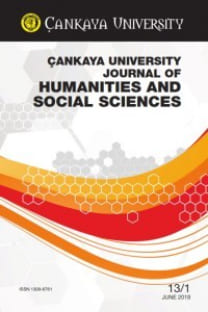Chaucer’ın Düşes’in Kitabı adlı Şiirinde Hastalık ve İyileşmeye Dair
Chaucer’ın rüya şiirleri, yazar olmak isteyen anlatıcının sorunlarının rüya yetkilileri tarafından çözülerek anlatıcının iyi bir yazar olmasına yardımcı olmaya çalışan iyileştirmeye yönelik anlatılardır. Aslında hastalık ve hastalığı iyileştirme yolları Chaucer’ın ilk rüya şiiri Düşes’in Kitabı şiirinin temel konusunu oluşturur. Düşesin Kitabı’nın durumunu uzun süredir devam eden bir hastalık olarak tanımlayan ve okuduğu üzüntülü ve acılı bir hikayede uykusuzluğuna çare arayan bir anlatıcısı vardır. Anlatıcının rüyası bir sevgilinin ölümü ve sağ kalan sevgilinin buna bağlı olarak çektiği acıyı anlatır. Kara Ölüm olarak adlandırılan vebada olduğu gibi sürekli bir hastalık hali sunan Düşes’in Ölümü şiiri hastalık ve hastalığın sebep olduğu çaresizlik durumu açısından yazımında rol alan Kara Ölüm’ü çağrıştırır. Şiir iyileşme ihtimalleri sunmakla birlikte bu ihtimallerin sorunlu ve gerçekleşmesi zor olduğunu da gösterir. Bu makale, Düşes’in Ölümü şiirinin iyileştirici özelliğini vurgulayan teselli edici özelliği yanı sıra, mevcut tedavi yöntemlerine dirençli bir hastalıkları olduğundan sağlıksız ve ölümle yüz yüze olan karakterleri yoluyla tedavi ihtimallerini zayıflatan bir hastalık temasını temel alıp geliştirdiğini savunur.
Anahtar Kelimeler:
Chaucer, Düşes’in kitabı, Rüya şiir, hastalık ve sağlık, veba
Speaking of Sickness and Healing in Chaucer’s Book of the Duchess
Chaucer’s dream poems are curative narratives which to a large extent engage with the narrator’s problems as an aspiring writer as problems to be remedied by the dream authorities so that the narrator can become a good writer. Indeed, the idea of a disease and possible ways of curing it are central to Chaucer's first dream narrative, the Book of the Duchess. The Book of the Duchess introduces a narrator who identifies his condition as a sickness of a long time and continues with a search for curative alternatives for his sleeplesness in a story of loss and grief. The narrator’s dream narrative presents a story of the death of a beloved and grief of the surviving partner. In its engagement with sickness and frustration caused by lack of healing prospects the Book of the Duchess echoes its originary occasion, the Black Death, as it represents a persistent state of sickness similar to the one caused by the Black Death. Although the possibilities of healing are there to be considered, they are problematic and difficult to realize. This paper argues that along with its consolatory dialectics that foregrounds the curative role of the poem, the Book of the Duchess develops and centralizes a poetics of sickness that undermines the possibilities of healing in its presentation of characters as unhealthy people facing death because of an illness resistant to existing forms of treatment.
Keywords:
Chaucer, Book of the Duchess, dream poetry, sickness and healing, Black Death,
___
- Boccaccio, Giovanni. Decameron. Trans. G.H. McWilliam. Harmondsworth: Penguin, 1972.
- Bowsky, William M. Ed. The Black Death: A Turning Point in History? Huntington, New York: Krieger, 1978.
- Buckler, Patricia Brandini. “Love and Death in Chaucer’s Book of the Duchess” in Joanna Stephens Mink and Janet Dobbler Ward. Eds. Joinings and Disjoinings: The Significance of Marital Status in Literature. Bowling Green, Ohio: Bowling Green University Popular Press, 1991, pp. 6-18.
- Butterfield, Ardis. “Pastoral and the Politics of Plague in Machaut and Chaucer.” Studies in the Age of Chaucer, Vol. 16, 1994, pp. 3-27.
- Butterfield, Ardis. “Lyric and Elegy in the Book of the Duchess.” Medium Ævum, Vol. 60, No. 1, 1991, pp. 33-60. Byrne, Joseph P. Daily Life During the Black Death. Westport, Connecticut and London: Greenwood Press, 2006.
- Cantor, Norman F. In the Wake of the Plague: The Black Death and the World It Made. New York: Simon & Schuster, 2001.
- Chaucer, Geoffrey. The Riverside Chaucer. Larry D. Benson. Gen. Ed. 3rd ed. Oxford: Oxford University Press, 1988.
- Condren, Edward L. “The Historical Context of the Book of the Duchess: A New Hypothesis.” The Chaucer Review, Vol. 5, No. 3, Winter, 1971, pp. 195-212.
- Foster, Michael. “On Dating the Book of the Duchess: The Personal and Social Context.” The Review of English Studies, New Series, Vol. 59, No. 239, 2007, pp. 185-196.
- Fumo, Jamie C. Making Chaucer’s Book of the Duchess: Textuality and Reception. Cardiff: University of Wales Press, 2015.
- Grennen, Joseph H. “Heart Hunting in the Book of the Duchess.” Modern Language Quarterly, Vol. 25, 1964, pp. 131-39.
- Hill, John M. “The Book of the Duchess, Melancholy, and That Eight-Year Sickness.” The Chaucer Review, Vol. 9, No.1, Summer, 1974, pp. 35-50.
- Horowitz, Deborah. “An Aesthetic of Permeability: Three Transcapes of the Book of the Duchess.” The Chaucer Review, Vol. 39, No. 3, 2005, pp. 259-79.
- Horrox, Rosemary. Trans. and Ed. The Black Death. Manchester and New York: Manchester University Press, 1994.
- Machaut, Guillaume de. Jugement dou Roy de Navarre. 22 Apr. 2022, d.lib.rochester.edu/teams/text/palmer-machaut-thedebateseries-navarre.
- Middleton, Ann. “The Idea of Public Poetry in the Reign of Richard II.” Speculum, Vol. 53, 1978, pp. 94-114.
- Muscatine, Charles. Chaucer and the French Tradition. Berkeley: University of California Press, 1957.
- Olson, Glending. Literature as Recreation in the Later Middle Ages. Ithaca: Cornell University Press, 1982.
- Petrarch, Francesca. Letters on Familiar Matters, “Preface,” Petrarch, Epistolea de Rebus Familiaribus et variae. Ed. Joseph Fracasseti, Florence, 1859, I, III. In Horrox, Rosemary. Trans. and Ed. The Black Death. Manchester and New York: Manchester University Press, 1994, pp. 248-49.
- Robertson, D. W. A Preface to Chaucer. Princeton, N.J.: Princeton University Press, 1962.
- Wimsatt, James I. Chaucer and the French Love Poets. Chapel Hill: University of North Carolina Press, 1968.
- ISSN: 1309-6761
- Yayın Aralığı: Yılda 2 Sayı
- Başlangıç: 2004
- Yayıncı: Çankaya Üniversitesi
Sayıdaki Diğer Makaleler
Berlin’in Psikocoğrafyası: David Hare’in Berlin ve Mark Ravenhill’in Over There Adlı Oyunları
Türkçe’de Kanıtsallığa Kullanıma Dayalı Yapı Gramer Yaklaşımı: Kanıtsallık Yapısı
Chaucer’ın Düşes’in Kitabı adlı Şiirinde Hastalık ve İyileşmeye Dair
Feride SÜMBÜL, Selmin SÖYLEMEZ
Asterix’te Özel İsimlerin Sinhala’ya Çevirisi Üzerine
Samanthi JAYAWARDENA, Judith Sumindi RODRİGO
